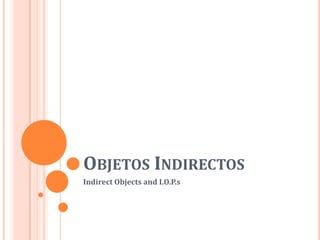
Indirect Objects
- 1. Objetos Indirectos Indirect Objects and I.O.P.s
- 2. You’ve been using I.O.P.s without even realizing it…! Megusta la comedia. The comedy is pleasing to me. Legustanlas papas fritas. French fries are pleasing to him). Lesgusta la cantante. The singer is pleasing to them. Nos gustan las películas de ciencia ficción. Sciencefictionmovies are pleasingtous.
- 3. Indirect Objects and I.O.P.s Indirect Objects answer the questions: TO whom? FOR whom? Doyunacamisa a mi amigo IO: a mi amigo (to my friend) Le doyunacamisa IOP: le (to him)
- 4. Since you’ve been using I.O.P.s since Español 1… Can you figure out what the I.O.P.s are? (think gustar…)
- 5. Direct Objects (and DOPs) and Indirect Objects (and IOPs) Direct Object: Compré los libros. What’s being bought? DOP: Loscompré. Compré loslibrospara mi madre. For whom did you buy the book? For my mom IOP.:Lecomprélos libros.
- 6. Joined at the hip:Indirect Objects are clingy! Where you find an I.O.(P.), you will (usually) find a D.O.(P.) The indirect object tells WHERE the direct object is going. Tedoyunaflor. What’s being given? A flower. To whom is it being given? To you.
- 7. Sometimes you don’t see the DO(P)… Mi madremeescribecadasemana. What’s being written? A letter (implied) To whom is it being written? To me Mi madremeescribeunacartacadasemana.
- 8. But can you have a direct object without an indirect object? Comíunamanzana. What’s being eaten? An apple To/for whom is it being eaten? HUH?!? So…. YES, you can.
- 9. Placement of IOPs Rule 1: Before the conjugated verb doy un abrazo Rule 2: Attached to a non-conjugated verb (and ando/iendo) Quierodar un abrazo Estaba comprándo una camisa Te te te
- 10. Coming soon to a classroom near you… Verbs like gustar IOPs AND DOPs in the same sentence! Get excited!!!